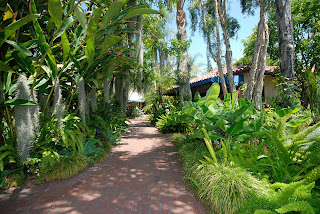 |
| The garden surrounding Conway Recording |
I was talking to a friend about the studio business in Los Angeles the other day when the conversation drifted to a very famous studio that was slowly being phased out (guess which one below). That got me thinking about some of the great studios that I've worked in over my career as well as some others that are on my bucket list. I decided to make a list of the 10 studios that I believe everyone connected with recording should visit at least once.
Actually there were many more than 10, but these are what I consider the top 10 that come to mind.
1. Abbey Road (London) - The center of the recording universe for decades, the studio that everyone most wants to visit, and what many feel has always represented the epitome of recording excellence.
2. Capitol Records (Los Angeles) - All you have to do is walk down the hallway and see the huge pictures of Frank and Dean and the realization of the studio's history hits you. Great sounding rooms, not to mention the famous echo chambers. Major construction in the area might seriously affect the studio in the near future.
3. Sunset Sound (Los Angeles) - One of the first independent studios anywhere, it's been the home to hit makers since the early 60s. I went to the 25th anniversary party a number of years ago and they played the hits that were made there in the background for four hours and never repeated one.
4. East West (Los Angeles) - Once part of
Bill Putnam's United Western (also one of the first indie studios), the studios have remained basically the same since Bill designed them.
5. Oceanway (Los Angeles) - The other part of United Western and until recently, owned by
Allan Sides, the studio is now owned by
Gower film studios and its future is in doubt. See it while you can.
6. Electric Lady (New York) -
Jimi Hendrix's personal studio. His vibe is still there. Enough said.
7. The Record Plant (Los Angeles) - It's not at the original location anymore, but it's still a legend just for the who's-who list of clients.
8. Henson (Los Angeles) - The former
A&M Studios located on the old
Charlie Chaplin film lot, Henson is one of the few large facilities left. Once again, the home of legends.
9. Conway (Los Angeles) - Mostly under the radar, Conway has been the home to music celebs for decades. You can't beat the beauty of the tropically themed grounds around the studio, which makes it one of a kind.
10. Avatar (New York) - Formerly the
Power Station, Avatar has been the home to East Coast hit makers for decades, as well as the place where many of today's most influential engineers got their start.
That was an easy 10, and we didn't even get to Nashville, Memphis and the rest of London, as well as some of the famous studios that are now museums like
Motown, Sun and
RCA Studio B. Plus it was very LA-centric. Forgive me, my studio friends, if I left your favorite off the list. If you guys like this one, I'll post a second one soon.
----------------------------------



